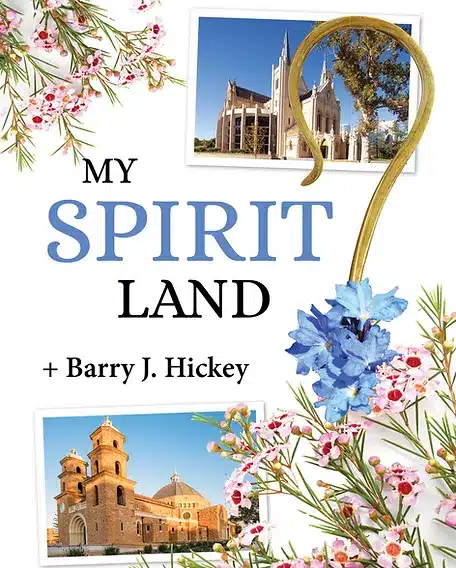
“History is generally about the big picture. These pages are the little picture of one person,” Archbishop Emeritus Barry Hickey writes in the introduction to My Spirit Land, the memoir of his life and ministry.
But the emeritus archbishop of Perth’s “little picture” is of the “big events” of the church’s tumultuous latter 20th century, making My Spirit Land the child of two competing genres of memoir—a “history from below,” and a post-retirement reflection on the administrator’s daily diary.
The memoir is also shaped by its geography: Sydney readers will detect a touch of Western Australian remoteness, and the priority of the local over the universal.
My Spirit Land will therefore attract three separate readerships. First, those who have known and worked with the archbishop, mostly Western Australians: clergy, religious and laity, family and friends, church workers and rough-sleepers.
The characters who receive affectionate treatment in hundreds of short vignettes would not otherwise be remembered for posterity, giving the memoir its heart and soul. Yet these episodes may be of lesser interest to those who did not know the author or serve with him, and My Spirit Land may mostly be of local interest.
The second readership will be those looking for the archbishop’s view on the crucial events of his time—the expected audience of an episcopal memoir. Given Archbishop Hickey’s reputation as a defender of the church’s traditional teaching on marriage, and of Humanae Vitae, it is fitting that the sexual revolution of 1968 and its aftermath receive comparatively more attention and give the memoir an arc of sorts.
In 1968 Archbishop Hickey was a student priest at the University of Western Australia, where he had been sent to study social work and prepare to “take over the church’s welfare work.”
He was working on the Marriage Guidance Council, while discussing the new sexual ethics with his fellow students on campus. Despite the spirit of revolution in the air, he enjoyed how the non-Catholic students treated him with a lack of deference, which he found “refreshing.”
Nevertheless, he still bore the full brunt of the Age of Aquarius. In one illustrative episode, after a marriage guidance conference in Canberra, then-Fr Hickey was taken by a friend to a bush pool outside the city to witness the new way of things.
“[C]ouples swam with little or nothing on, and young people openly made love, not war … I was glad to move on,” he recalls.
Taking his friend to the airport, she reproached him for his aloofness, saying he was “living in a suit of armour, unapproachable and self-protective.”
“This stayed with me for a long time and I think she was partially right,” the archbishop writes. He later attended her funeral, at which few people were present.
“By now, more than fifty years later, does anyone in this world remember her? I am perhaps the last one … Why I mention all this is because the new freedom was everywhere. We were not expecting it and were not ready. I certainly wasn’t.”
The pastor struggling alongside others, finding his vocation challenged but keeping it together, appreciating reform while grieving the chaos wreaked on others by the cruelties of change—this episode typifies My Spirit Land’s Catholic moral register, even if much of the text is a record of the year-on-year business of running an archdiocese.
Archbishop Hickey’s accounts of the other major events of his time, the Second Vatican Council and child abuse crisis, are of a similar character, appraised by how they challenged the priesthood and broke like waves over the church’s faithful.
The final third of the book undergoes a shift in tone, as the archbishop’s longstanding circle of friends begins to dwindle through age, sickness and death.
The passing of his friend Fr Tim Foster in 2020 is punctuated with a sad reflection on the memoirist’s task: “This seems to be turning into a necrology again. I’m sorry, but it is to be expected that one loses friends at my age.”
The memoir’s final entry, the funeral of Cardinal George Pell, is one of many that shows the author’s admiration for the Cardinal’s protagonism in Australian Catholic life.
For a “little picture” memoir, My Spirit Land clocks in at a gargantuan 600 pages. Its size poses nearly fatal problems for the average reader, and especially for its third readership: historians.
The book itself is a demanding read, warm in tone but in want of internal organisation, and written chronologically as a stream of consciousness in short episodes of a few hundred words each.
The absence of an index—even an index of names—is noticeable in a memoir of this style and scope.
Historians may find it a difficult source to work with in future decades—but as the archbishop indicates, history is not his intended audience.
Nevertheless, a second edition, if one is produced, would do well to amend these omissions.
As an exercise in Christian memoir My Spirit Land shines with the temperament of the archbishop and his generation.
Vatican II called the church to see itself as a pilgrim in the midst of history, and My Spirit Land faithfully follows this spirit.
Archbishop Hickey clearly is no introvert, and sees the church’s vast company of pilgrims as necessary for his own life’s meaning, especially the poor, whom he sincerely loves and knows by name.
He writes like a pastor at prayer, holding those he knows and loves before God. This is an essential mark of the church, which remembers those whom the world, and history, are liable to forget.
